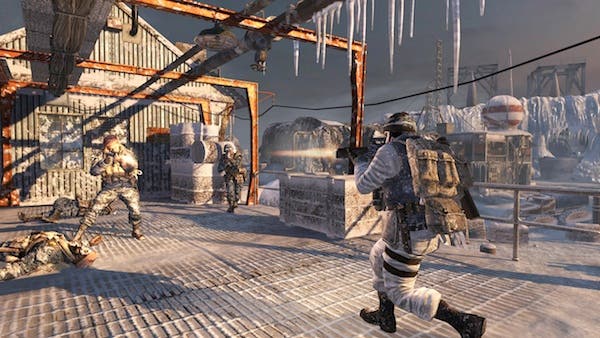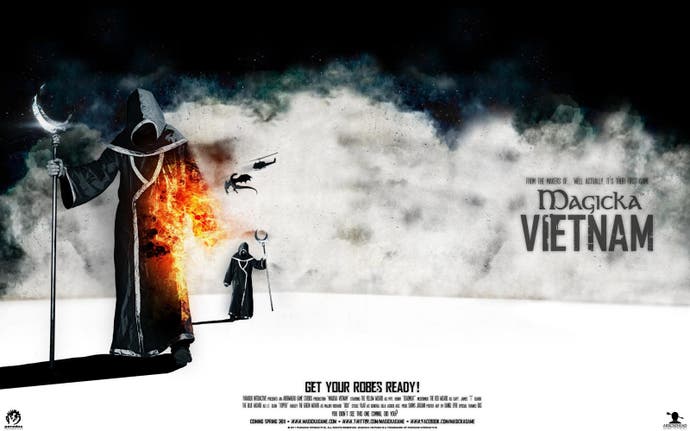Saturday Soapbox: The (first) DLC generation
Has the content pack come of age?
Kameo: Elements of Power didn't just help kick off the current console generation, it played a role in the early days of one of its more interesting - and divisive - trends, too. Shortly after the Xbox 360 came out in December 2005, I went over to my friend - and handy early adopter - Stu's house to see what the new hardware could do. Stu was playing Kameo, which looked colourful and pleasant and busy with particle effects, but there was something else taking place on the screen that seemed completely weird. As Christmas inched closer in the real world, Christmas was inching closer in Kameo, as well: all the elves and pixies, grunts and lumbering yeti-type things the protagonist could transform into were decked out in scarlet pom-pom hats and little red and white ruffs. Santa Claus had come to toy town.
Rare's Winter Warrior Pack (yours today for a peppy 80 MSP) will hardly go down in history as one of the truly great pieces of DLC, but it served its purpose well enough, convincing me that here was something new and powerful and a little bit nutty. Taking a leaf from PC titles, console games could now change over time if you wanted them to, and in a way that went beyond simple patching (which was itself quite novel for the console crowd). The world stored on the disk could react to seasonal traditions or bend to the will of well-off loot fiends who wanted to microtransaction their way to glory. It could be meddled with, updated, and ultimately expanded. The future was bright - and it was filled with hats!
It's been a bit of a bumpy journey since then. We've learned the strange sting of that tiny, expensive DLC download that informs you that the stuff you just bought was already on the disk that you, y'know, had also already bought. We've been nickle-and-dimed as publishers carve add-ons up into tiny, rather pricy lumps, and we've been sold mishandled campaign additions, endless limp horde modes, naff challenge rooms and horse armour. We've been encouraged to get into the habit of referring to games - magical, mesmerising, transporting games - as content.

We've also, though, been given access to brilliant new campaign additions, excellent horde modes and challenge rooms, and other updates that weren't on the disk, didn't serve to merely sartorially buff our four-legged buddies and have sometimes even provided the defining moments for the games they enhance. This has truly been the DLC generation - the first DLC generation, anyway - and it feels like we've come a long way from that moment when I first glimpsed Rare's Winter Warriors.
I was thinking about all of this recently, having just played through Borderlands 2's first couple of DLC instalments in order to get to level 30 so I could play the third. Grinding a game for a specific objective like this, even when you really enjoy the game in question, is generally the quickest, nastiest way of ruining the whole thing for yourself, but Borderlands 2 survived the experience surprisingly well - and I think that's down to the DLC.
Gearbox uses its downloadable expansions to create something that feels a bit like those weird episodes of Moonlighting or Community where everyone speaks in iambic pentameter or becomes an animated model for a half hour - or perhaps those Star Trek storylines that were set exclusively on the Holodeck. The campaign's safely over, or at least put on hold, so the DLC works like holiday specials and self-contained alternate reality narratives: new locations, new antagonists, and new ways of telling stories about shooting lots and lots of people before pulling guns and ammo out of their steaming corpses.
Actually, the holiday special analogy struck me quite forcefully back when I played the first game's initial DLC salvo, The Zombie Island of Dr Ned. Here was a Halloween story filled with leering pumpkins and spooky ghost towns - in true Borderlands fashion, it arrived around Christmas, of course - and it felt no obvious need to match the tone of the wider game stored on the disk. It was a few hours that seemed to see the audience moving closer to the design team - you could buy it without leaving your favourite gaming chair, and the main adventure had smart jokes about asset re-use and general production corner-cutting. It seemed more playful than usual, and a little more intimate.

Since then, alongside arena stuff in the form of Mad Moxxi and her Underdome Riot, Gearbox's audience has had adventures like The Secret Armoury of General Knoxx, which seemed to be there in order to make up for the disappointing ending of the main campaign (with Mass Effect 3, this strategy would become something of a trend) and, most recently, Captain Scarlett and her Pirate's Booty, a pirate-themed adventure that works a bit like a new funfair ride at the Borderlands theme park. Then there's Mr Torque's Campaign of Carnage, which ditches the main vault hunting narrative in order to explore the Shakespearian machinations of professional wrestling. Disparate as these packs are, they all have one thing in common: they're reactions to the finished game, and reactions to the things people like about the finished game. Making a massive big budget title - even a sequel - must often feel like working in the dark. Post-release, you're making stuff with a little more light to see by.
Borderlands isn't alone by any means, of course. Off the top of my head, GTA, The Elder Scrolls and Fallout 3 have all created expansions that either experiment with the kind of stories being told or throw in a markedly different kind of character to explore. Interestingly, these are all fairly systemic games, making it relatively easy to add new and distinct elements while the levelling - or the car-jacking - maintains a crucial sense of coherence. Speaking of coherence, a couple of years back, the big thing we were all excited about was the prospect of episodic games. Now, alongside genuine series like The Walking Dead, we've got these DLC additions blurring the lines between triple-A productions and episodic content. Halo 4 even calls its Spartan Ops download groupings seasons. The wonky comparison big budget games often face is with movies; a few years from now, will DLC mean that the new wonky comparison could be boxsets?
New missions aren't the only thing that works, of course: Xcom's recent update allowed players to meddle with a series of settings and toggles that could make a hard game even harder. With the main project behind them, the team clearly felt free of the need to ensure the whole thing was balanced, and what you end up with is a kind of Xcom: Variations package, which is as fascinating as it sounds. Design freedom like this is a big part of the appeal of great DLC, actually: think about Mirror's Edge's Pure Time Trial Map pack, colourful, abstract assault courses that made a stylish game yet more striking, while ditching all but the most essential of mechanics. It's hard to play that without wondering, even for just a rogue second or two, if this is the game the designers would have made if they could truly have done what they wanted. Is this the game free of undue intervention from the suits?

It's not all been great. For every Borderlands, every Elder Scrolls, every Trials or Minerva's Den, for every developer that approaches DLC with a certain degree of flair and attention to detailing, there's a teetering pile of forgettable character reskins and bland multiplayer arenas building up. Again, there are things being sold that are already on the disk, things being sold that should have been on the disk, and things being sold that should never have been on the disk, and should never have been anywhere else either. Some games, it turns out, are simply shipped whole, for good or ill, and you can't then add much to them of value. Meanwhile, download codes and online passes have excluded first-time buyers without internet connections from accessing single-player offline content they've legitimately paid for, while noble-ish failures, like Duke Nukem's DLC The Doctor who Cloned Me have given developers a second crack at making what feels like a main campaign, only to see it fall foul of the same old problems.
There's roughly enough good to counter the bad, though, which isn't bad for a business practice that probably emerged largely from the desire to see players holding onto old games rather than trading them in again. Over the course of a single generation, DLC has made steps from being a novelty or a clumsy appendage towards something that often feels substantial and sometimes - as in the case of Borderlands - even crucial. At its very best, DLC's a chance to see the host game after that energising period of reflection: you sense the developers have had a chance to step back, fully understand what they've built, and then apply the things they've learned.
Whatever the next generation holds, it looks likely that we're going to see more of this, as console business models become harder to distinguish from PC or even mobile approaches - DLC wasn't as new for PC gamers as it was for 360 and PS3 owners, after all, while few developers have taken content updates to heart as seriously - or implemented them in as many different ways - as those making games for smartphones.
That's what I glimpsed when I looked at Kameo's Christmas hats, I guess: games used to have to draw a line around themselves - now they increasingly don't, and that's pretty exciting.

